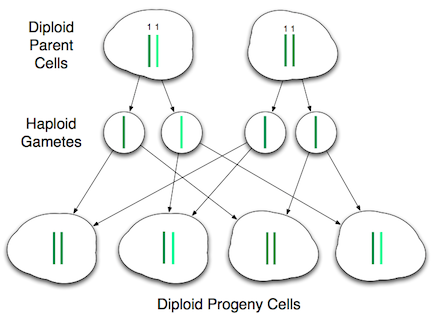The Punnett Square
A
Punnett Square
is a really useful tool for determining the outcome of genetic crosses in which some
genes
are
dominant
and some are
recessive
. By using a
Punnett Square
it is possible to work out the likelihood of certain particular
genotypes
occurring as a result of the combination of different
alleles
.
The method is named after Professor Reginald Crundall Punnett FRS (20 June 1875 - 3 January 1967) -
Further Information
.
If working with just one
gene
in a cross of
diploid
parents then the outcome is fairly easy to determine:

Crosses with one gene - With one gene, in diploid parents, it is fairly easy to work out the resulting genetic profile of any progeny, however, increase the number of genes, and things soon start to get complicated!
As can be seen in the above figure, two
diploid
parent cells containing one
gene
of interest with two
alleles
(
alleles
of the
gene
shown as dark green or light green) can each produce 2
haploid gametes
gametes
(in the case of the parent cell on the left one dark green and one light green; and the parent on the right, two dark green). These
gametes
can fuse in 4 possible ways to produce 4
diploid
offspring, two containing 2 dark green
genes
, and 2 containing one dark green and one light green, and these different combination of
genes
may lead to different
phenotypes
.
If you have
heterozygous
parents with 2 different
genes
then there are 16 possible outcomes, 3
genes
gives 64 possible outcomes. (You can calculate the possible number of outcomes using 2
(2x), where x = number of
genes
.) Therefore, trying to work out crosses with more than 2
genes
using the type of diagram above would be very complicated, hence the use of
Punnett Squares
.
It should be noted that the number of outcomes is NOT the same as the number of
genotypes
or
phenotypes
from a cross. In the above figure there are 4 possible outcomes, but only two
genotypes
(dark green/dark green, and dark green/light green), and depending on the function of the
gene
it could be 1 or 2
phenotypes
.
